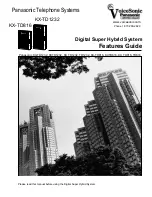
1.8 Toll Restriction (TRS) Features
64
Feature Guide
1.8
Toll Restriction (TRS) Features
1.8.1
Toll Restriction (TRS)
Description
Toll Restriction (TRS) can prohibit certain extension users from making unauthorised outside (CO) line calls.
Every extension is assigned to one of 5 classes of service (COSs) for each time service mode (
TRS-
COS—Day/Night/Lunch [601-603]); COS 1 grants the highest level of authorisation, allowing all outside
(CO) line calls to be made, and COS 5 grants the lowest level of authorisation. COSs 2 through 5 are used
to restrict calls with a combination of preprogrammed Denied and Exception Code Tables, explained below.
Denied Code Tables
(
TRS—COS 2-5 Denied Code [302-305])
Denied Code Tables are preprogrammed lists containing the telephone numbers that are restricted. All
outgoing outside (CO) line calls made by COS 2 through 5 users are compared to the applicable Denied
Code Table(s), and when the leading number of a dialled telephone number (not including the Outside (CO)
Line Access number) matches an entry found in an applicable table, the call is denied.
Up to a total of 80 denied codes, each consisting of up to 11 digits, can be stored.
Exception Code Tables
(
TRS—Exception Code [306])
Exception Code Tables are preprogrammed lists of leading digits or complete telephone numbers that are
checked against every dialled number prohibited by a Denied Code Table. When a dialled number is
prohibited by a Denied Code Table, it is compared to the applicable Exception Code Table(s). If the dialled
number matches an entry found in an applicable Exception Code Table, the call is permitted.
Up to 80 exception codes, each consisting of up to 11 digits, can be stored. The available number of codes
depends on the COS assigned to each extension.
Applicable tables by COS
The Denied Code Tables and Exception Code Tables that apply to each COS are listed below.
COS No.
Denied Code Tables
Exception Code Tables
1
No restriction.
(Not Programmable)
No restriction.
(Not Programmable)
2
20 denied codes programmed in [302].
(Table for Class 2)
80 exception codes (code numbers 01–80)
programmed in [306].
(Tables for Classes 2 through 5)
3
40 denied codes programmed in [302] and
[303].
(Tables for Classes 2 and 3)
60 exceptions codes (code numbers 01–60)
programmed in [306].
(Tables for Classes 3 through 5 )
4
60 denied codes programmed in [302]
through [304].
(Tables for Classes 2 through 4)
40 exception codes (code numbers 01–40)
programmed in [306].
(Tables for Classes 4 and 5)
5
80 denied codes programmed in [302]
through [305].
(Tables for Classes 2 through 5)
20 exception codes (code numbers 01–20)
programmed in [306].
(Table for Class 5)
Summary of Contents for KX-TEB308
Page 13: ...Feature Guide 13 Section 1 Call Handling Features ...
Page 154: ...1 22 Audible Tone Features 154 Feature Guide ...
Page 155: ...Feature Guide 155 Section 2 System Configuration and Administration Features ...
Page 167: ...2 3 System Data Control Feature Guide 167 3 2 PC Programming ...
Page 181: ...Feature Guide 181 Section 3 Programming Instructions ...
Page 252: ...3 3 PT Programming 252 Feature Guide ...
Page 253: ...Feature Guide 253 Section 4 Appendix ...
Page 262: ...4 2 Tones Ring Tones 262 Feature Guide ...
Page 263: ...Feature Guide 263 Index ...
Page 269: ...Index Feature Guide 269 ...




































